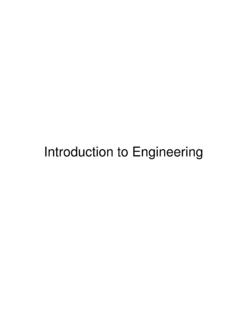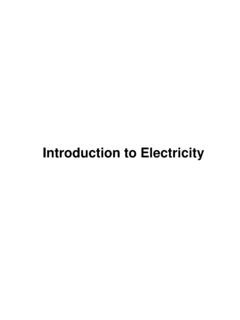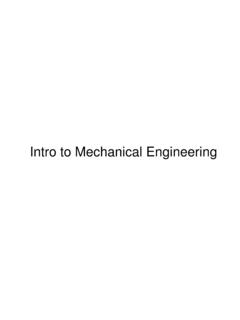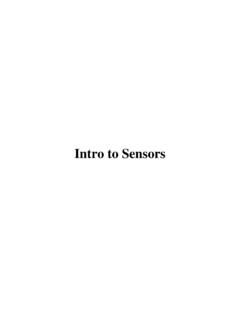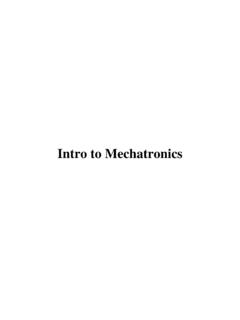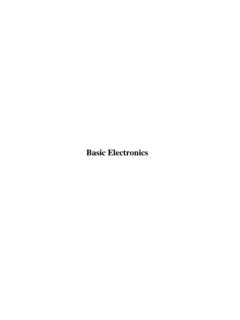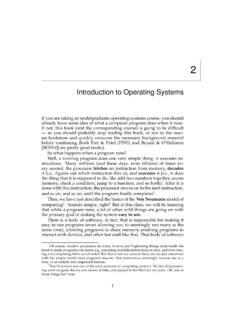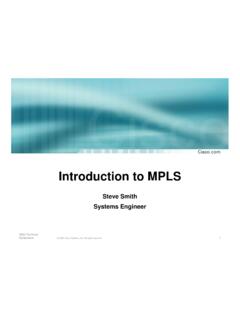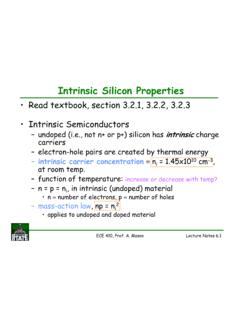Transcription of Intro to Sensors - engineering.nyu.edu
1 Intro to SensorsOverview Sensors ? Commonly Detectable Phenomenon Physical Principles How Sensors Work? Need for Sensors Choosing a Sensor ExamplesSensors? American National Standards Institute A device which provides a usable output in response to a specified measurand A sensor acquires a physical quantity and converts it into a signal suitable for processing ( optical, electrical, mechanical) Nowadays common Sensors convert measurement of physical phenomena into an electrical signal Active element of a sensor is called a transducerTransducer?A device which converts one form of energy to anotherWhen input is a physical quantity and output electrical SensorWhen input is electrical and output a physical quantity Actuator ActuatorsSensorsPhysical parameterElectrical OutputElectrical InputPhysical Piezoelectric:Force -> voltageVoltage-> Force => Ultrasound!
2 Microphone, Loud SpeakerCommonly Detectable Phenomena Biological Chemical Electric Electromagnetic Heat/Temperature Magnetic Mechanical motion (displacement, velocity, acceleration, etc.) Optical RadioactivityCommon Conversion Methods Physical thermo-electric, thermo-elastic, thermo-magnetic, thermo-optic photo-electric, photo-elastic, photo-magnetic, electro-elastic, electro-magnetic magneto-electric Chemical chemical transport, physical transformation, electro-chemical Biological biological transformation, physical transformationCommonly Measured QuantitiesTemperature, Flux, Specific Heat, Thermal ConductivityThermalPosition, Velocity, Acceleration, Force, Strain, Stress, Pressure, TorqueMechanicalRefractive Index, Reflectivity, AbsorptionOpticalMagnetic Field (amplitude, phase, polarization), Flux, PermeabilityMagneticCharge, Voltage, Current, Electric Field (amplitude, phase, polarization)
3 , Conductivity, PermittivityElectricFluid Concentrations (Gas or Liquid)Biological & ChemicalWave (amplitude, phase, polarization), Spectrum, Wave VelocityAcousticQuantityStimulusPhysical Principles: Examples Amperes s Law A current carrying conductor in a magnetic field experiences a force ( galvanometer) Curie-Weiss Law There is a transition temperature at which ferromagnetic materials exhibit paramagnetic behavior Faraday s Law of Induction A coil resist a change in magnetic field by generating an opposing voltage/current ( transformer) Photoconductive Effect When light strikes certain semiconductor materials, the resistance of the material decreases ( photoresistor)Choosing a SensorNeed for Sensors Sensors are pervasive. They are embedded in our bodies, automobiles, airplanes, cellular telephones, radios, chemical plants, industrial plants and countless other applications.
4 Without the use of Sensors , there would be no automation !! Imagine having to manually fill Poland Spring bottlesMotion Sensors Monitor location of various parts in a system absolute/relative position angular/relative displacement proximity acceleration Principle of operation Magnetic, resistive, capacitance, inductive, eddy current, SecondaryLVDT Displacement SensorOptoisolatorPotentiometerStrain Gauge: Motion, Stress, PressureStrain gauge is used to measure deflection, stress, pressure, etc. The resistance of the sensing element changes with applied strainA Wheatstone bridge is used to measure small changes in the strain gauge resistanceTemperature Sensor: Bimetallic Strip Bimetallic Strip Application Thermostat (makes or breaks electrical connection with deflection))]T-(T1[00 LLTemperature Sensor: RTD Resistance temperature device (RTD) 011000)]T-(T1[TTeRRRR Other Temperature Sensors Thermistor Thermocouple: Seeback effect to transform a temperature difference to a voltage difference ResistorThermalTherm istor exp2gERkT Capacitance Transducers I Recall, capacitance of a parallel plate capacitor is: A: overlapping area of plates (m2) d: distance between the two plates of the capacitor (m).
5 Permittivity of air or free space dielectric constant0 0rACd :r The following variations can be utilized to make capacitance-based Sensors . Change distance between the parallel electrodes. Change the overlapping area of the parallel electrodes. Change the dielectric escape holeairFuel tankParallel plate capacitorAccelerometer I Accelerometers are used to measure acceleration along one or more axis and are relatively insensitive to orthogonal directions Applications Motion, vibration, blast, impact, shock wave Mathematical description is beyond the scope of this presentation. Accelerometer II Electromechanical device to measure acceleration forces Static forces like gravity pulling at an object lying at a table Dynamic forces caused by motion or vibration How they work Seismic mass accelerometer: a seismic mass is connected to the object undergoing acceleration through a spring and a damper; Piezoelectric accelerometers: a microscopic crystal structure ismounted on a mass undergoing acceleration; the piezo crystal is stressed by acceleration forces thus producing a voltage Capacitive accelerometer: consists of two microstructures (micromachined features) forming a capacitor; acceleration forces move one of the structure causing a capacitance changes.
6 Piezoresistive accelerometer: consists of a beam or micromachined feature whose resistance changes with acceleration Thermal accelerometer: tracks location of a heated mass during acceleration by temperature sensing Automotive: monitor vehicle tilt, roll, skid, impact, vibration,etc., to deploy safety devices (stability control, anti-lock breaking system, airbags, etc.) and to ensure comfortable ride (active suspension) Aerospace: inertial navigation, smart munitions, unmanned vehicles Sports/Gaming: monitor athlete performance and injury, joystick,tilt Personal electronics: cell phones, digital devices Security: motion and vibration detection Industrial: machinery health monitoring Robotics: self-balancingAccelerometer ApplicationsWII Nunchuk: 3 axis accelerometer2 axis joystickSegwayHelmet: Impact DetectionMX2125 Accelerometer.
7 How it Works A MEMS device consisting of a chamber of gas with a heating element in the center four temperature Sensors around its edge Hold accelerometer level hotgas pocket rises to the top-center of the accelerometer s chamber allsensors measure same temperature Tilt the accelerometer hotgas pocket collects closer to one or two temperature Sensors sensorscloser to gas pocket measure higher temperature MX2125 electronics compares temperature measurements and outputspulses (pulse duration encodes sensor o/p) Light Sensor Light Sensors are used in cameras, infrared detectors, and ambient lighting applications Sensor is composed of photoconductor such as a photoresistor, photodiode, or phototransistorPhotoresistors Light sensitive variable resistors.
8 Its resistance depends on the intensity of light incident upon it. Under dark condition, resistance is quite high (M : called dark resistance). Under bright condition, resistance is lowered (few hundred ). Response time: When a photoresistor is exposed to light, it takes a few milliseconds, before it lowers its resistance. When a photoresistor experiences removal of light, it may take afew seconds to return to its dark resistance. Photoresisotrs exhibit a nonlinear characteristics for incident optical illumination versus the resulting resistance. Symbol1010loglogRP R101103102101104102103104 Relative illumination (P)Magnetic Field Sensor Magnetic Field Sensors are used for power steering, security, and current measurements on transmission lines Hall voltage is proportional to magnetic fieldtqnBIVH Ultrasonic Sensor Ultrasonic Sensors are used for position measurements Sound waves emitted are in the range of 2-13 MHz Sound Navigation And Ranging (SONAR) Radio DectionAnd Ranging (RADAR) ELECTROMAGNETIC WAVES !
9 !15 -20 Photogate Photogatesare used in counting applications ( finding period of period motion) Infrared transmitter and receiver at opposite ends of the sensor Time at which light is broken is recor
